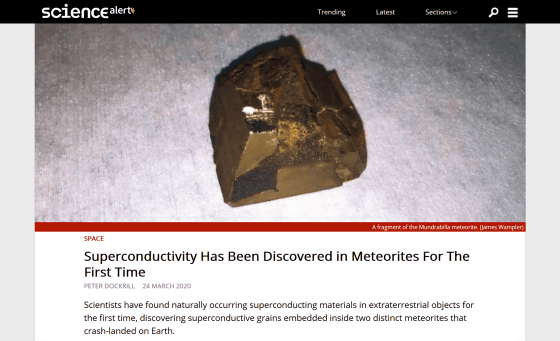Very rare superconducting substance is discovered in nature from meteorites

Superconductivity found in meteorites | PNAS
https://www.pnas.org/content/early/2020/03/17/1918056117
Scientists Find a Superconductor in Bits of Meteorite | Gizmodo UK
https://www.gizmodo.co.uk/2020/03/scientists-find-a-superconductor-in-bits-of-meteorite/
Superconductivity Has Been Discovered in Meteorites For The First Time
https://www.sciencealert.com/superconductivity-has-been-discovered-in-meteorites-for-the-first-time

Superconducting materials are already being used in measurement devices such as magnetic measurement devices and nuclear magnetic resonance imaging (MRI), and are also expected to be used in linear motor cars and quantum computers. On the other hand, very few superconducting materials have been found in nature, and almost all known superconducting materials have been created artificially.
Meanwhile, a research team
In the past, there have been reports of cases where rare substances were discovered from meteorites, and various substances were discovered from meteorites, such as extraterrestrial proteins , minerals that do not exist on earth, and substances older than the solar system. I am. However, there have been no reports of superconductors in meteorites.

by
The research team investigated the meteorite sample using a method called “magnetic field modulated microwave spectroscopy (magnetic field modulated microwave spectroscopy)” and checked whether superconducting materials exist inside the meteorite. In this analysis method, sample fragments are put into a hole filled with microwaves and an oscillating magnetic field, and the temperature is gradually lowered to determine whether or not the substance exhibits superconductivity. As the sample moves from conductor to superconductivity, the way the sample absorbs microwaves changes dramatically.
As a result of analyzing samples taken from 15 different meteorites, the research team found that one of the largest meteorites ever discovered in Australia in 1911 `` Mundravilla Meteorite '' and `` GRA '' discovered in the Arctic in 1995. 95205 'discovered a superconducting material from a meteorite. Considering the possibility that the sample was contaminated with the earth's material, the research team sent the sample to an external organization for inspection using an electron microscope, but the superconducting material contained in the meteorite was It was confirmed that it came from outside.
As a result of magnetic measurement using a vibrating sample magnetometer and energy dispersive X-ray analysis, the superconducting material discovered from the two meteorites was found to be an alloy of lead , indium, and tin . Although the composition of this superconducting material had already been discovered, `` Non-naturally occurring superconducting materials are rare, and these materials may actually exhibit superconductivity in extraterrestrial environments. Important, ”said James Wampler , lead author of the paper.

This time, the discovery of superconducting materials in small samples from two different meteorites, respectively, indicates that superconducting materials are likely to be present in large numbers in space. In addition, because there are extremely cold environments in outer space, the research team said, `` Superconducting materials in extremely cold regions may affect the composition of celestial bodies such as stars. 'And comment. He suggested that superconducting materials that became superconducting at extremely low temperatures affected the surrounding magnetic field and could have various effects.
Related Posts:
in Science, Posted by log1h_ik







